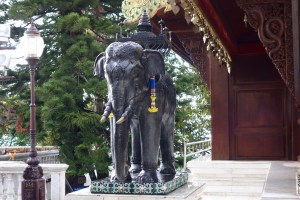We were sad to leave Luang Prabang, but new adventures await us. Next on our itinerary is Thailand’s second largest city, Chiang Mai. As our airplane approached the airport, we could see that the city was very spread out and, unlike Bangkok, did not have a center of high-rise buildings, but it does have 1,400 temples. No, we’re not going to see them all or even a few, but rather one. We met our guide, Audy, who has been a guide for 20 years, and headed to the most important Wat, the Phra That Doi Suthep Ratchawarawiha, built-in 1389 on top of the Doi Suthep mountain overlooking the city.

View of Chiang Mai.
As we arrived it started to rain. Removing our shoes and socks, and armed with rain ponchos and umbrellas, Audy took the opportunity to explain a couple of things about the temple. First, a temple or wat is defined to have four components: a Pagoda, a meditation and assembly room, an ordination room where monks are ordained, and a dormitory where the monks live. All four are present at this temple. The temple may also include several stupas, sponsored by individuals or families to intern the remains of family members or important individuals. The Doi Suthep temple is the most important temple in the area. Visitors come from throughout Thailand to meditate and to demonstrate respect to Buddha.

Temple
Audy told us the story behind the founding of the temple. According to legend, a monk had a vision which beckoned him to a specific location where he would find a relic which people claim to be a bone of the Buddha. He took this relic to his king. When confronted with the relic, the King rejected the relic as being special. However, the king of another province in Northern Thailand, hearing about this relic, invited the monk to bring it to him. Upon arrival, the bone broke in two. This king did believe it was a bone from Buddha, so he enshrined one piece in a temple in Suandok. The second piece was tied to the back of a white elephant that was released to wander into the jungle. The elephant climbed the Doi Suthep mountain. At the top he stopped, trumpeted three times, and died. Interpreting this as an omen, the King ordered the construction of the temple we are visiting today. Well, it IS just a legend!

Entrance to the temple.

Audi telling us the legend of the White Elephant.

One of several altars.

Da plane! Da plane!
When the rain ended, we moved out to see the various areas. Rain hadn’t dampened our enthusiasm, but it did help to clear out some of the crowds. Several 50-person tour groups vanished. We found more than a hundred statues of Buddha distributed throughout – differing materials, positions, and sizes. We learned that, depending on the day of the week you were born, a specific Buddha position was assigned to you. In the case of Roselie, her Buddha position is the reclining Buddha. We had fun discovering each of ‘our’ positions. It’s not clear whether this link is valid…seems more like astrology.

Recognizing the importance of the elephant to the people of the region.

Tuesday’s position: the contemplative Buddha.
In the pagoda, a monk seated on a raised platform blessed followers who came to pray to the Buddah. Roselie went in, kneeled in front of him, and was blessed with a sprinkle of water and a prayer… by the way, a woman can’t touch a monk, and her head must be lower than his. To her surprise, he spoke perfect English, and engaged in a cordial conversation, asking where she was from and had she visited Thailand before, while Roselie asked him if he had he been to the US, and when does he plan to visit. It was a fun exchange.

Roselie getting blessed by the monk.

Roselie is having a little chat with the monk.
While there were moments of mindfulness and acts of respect, such as the temple’s monks in prayer, chanting in their procession around the stupa, or a few followers kneeling in the square, bowing their heads as they prayed, the hundreds of statues, gold, precious stone, and lights was over the top. It was more of a spectacle, with swarms of tour groups invading every visual, physical, and sound space. We could not experience a quiet moment in thought or reflection. It was not a spiritual moment.

The main pagoda.

Monks chanting while walking around the pagoda.
Time to make our way to our hotel, which is near the center of town. It was a grueling drive through incredible traffic. It was like being in a parking lot. Fortunately, the skill and patience of our driver treated it as matter-of-fact and perfectly normal. It was an opportunity for Audy to give us a sense of the city, of the lifestyle. There is no mass transportation other than buses. Rather than taxis, hundreds of covered red pickup trucks ply the streets. They are similar to jump-on and jump-off busses, carrying several people in the bed of the truck. To catch a ride, merely wave down one heading in your direction. When he pulls over, ask whether he is going to your destination. If he is, agree on the fee and then jump into the back of the truck.
To end on a lighter moment, Helen asked Audy for the proper way to request a powder room stop. Well, for a woman, you say you want to “pick some flowers”, while men announce they want to “shoot some rabbits’. Thankfully we pull up to our hotel so we could all dash in to pick some flowers and shoot some rabbits.


コメント